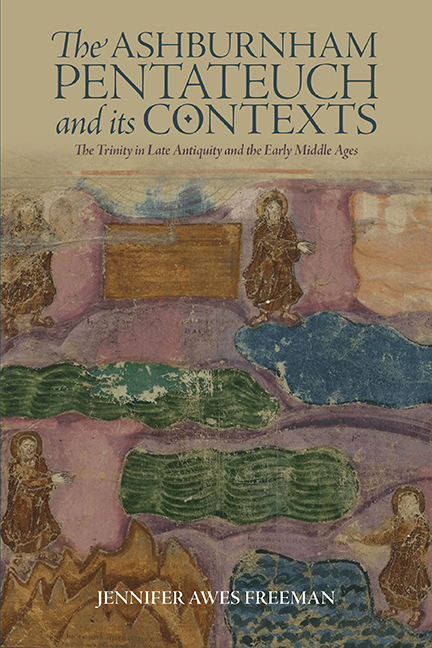Book contents
- Frontmatter
- Dedication
- Contents
- List of Illustrations
- List of Abbreviations
- Introduction: Losing and Finding the Ashburnham Pentateuch
- 1 Early Trinitarian Texts and Debates
- 2 The Trinity in Early Christian Images
- 3 Carolingian Conceptions of the Trinity
- 4 Carolingian Image Theory
- 5 The Carolingian Reception of the Ashburnham Pentateuch
- Conclusion: Possible Motivations for the Ashburnham Pentateuch Erasures
- Coda: The Afterlives of the Ashburnham Pentateuch
- Acknowledgments
- Bibliography
- Index
- ALREADY PUBLISHED
Coda: The Afterlives of the Ashburnham Pentateuch
Published online by Cambridge University Press: 26 May 2022
- Frontmatter
- Dedication
- Contents
- List of Illustrations
- List of Abbreviations
- Introduction: Losing and Finding the Ashburnham Pentateuch
- 1 Early Trinitarian Texts and Debates
- 2 The Trinity in Early Christian Images
- 3 Carolingian Conceptions of the Trinity
- 4 Carolingian Image Theory
- 5 The Carolingian Reception of the Ashburnham Pentateuch
- Conclusion: Possible Motivations for the Ashburnham Pentateuch Erasures
- Coda: The Afterlives of the Ashburnham Pentateuch
- Acknowledgments
- Bibliography
- Index
- ALREADY PUBLISHED
Summary
As with so many medieval manuscripts, the Ashburnham Pentateuch enjoyed something of an extended life as it was reimagined and repurposed – beginning with the liturgical notations that were added early on, followed by its role as inspiration for some Carolingian Genesis images, and most clearly as a model for the frescoes in St. Julien at Tours. After considering the Ashburnham Pentateuch's influence in the ninth and eleventh centuries, the following pages will briefly trace the life of the Ashburnham Pentateuch beyond the Middle Ages and conclude by returning to the events that led to some of its images gracing the pages of Frank Leslie's Sunday Magazine.
THE BIBLES AT TOURS
In addition to eliciting the erasures that have been the focus of this book, the Ashburnham Pentateuch also seems to have inspired copies to varying degrees. In the Carolingian era, this influence can be seen most clearly in the Genesis frontispieces of Bibles, mostly from Tours. In the Ashburnham Pentateuch, Eve is presented nursing in the top register of the folio (fol. 6r, fig. 7), seated on a bench beneath a dense green canopy. A postlapsarian makeover has given her drawn-up hair and purple garments. She is flanked by scenes of Adam and Eve after the Expulsion, and Cain and Abel making their offerings to God; Eve's role as mother is presented here as an introduction to the murder of Abel – that is, as further evidence of the consequences of her sin, which in turn is in keeping with the Church Fathers’ conception of her role as counterpart to the Virgin Mary.
In contrast, the Carolingian depictions of Eve nursing are visually linked to the Creation of Adam and Eve, and not to their postlapsarian lives, and unlike the Ashburnham Pentateuch's more organic, seemingly haphazard vignettes, the Carolingian manuscripts present their Creation images in clearly delineated registers. Still, a striking similarity is found in the depictions of Eve. For example, the Moutier-Grandval Bible (London, BL, Add. 10546, fol. 5v, fig. 26) presents Eve in the center of the bottom register of the miniature, seated on a mound of earth, partially draped in a red garment as she nurses an infant.
- Type
- Chapter
- Information
- The Ashburnham Pentateuch and its ContextsThe Trinity in Late Antiquity and the Early Middle Ages, pp. 181 - 190Publisher: Boydell & BrewerPrint publication year: 2022



